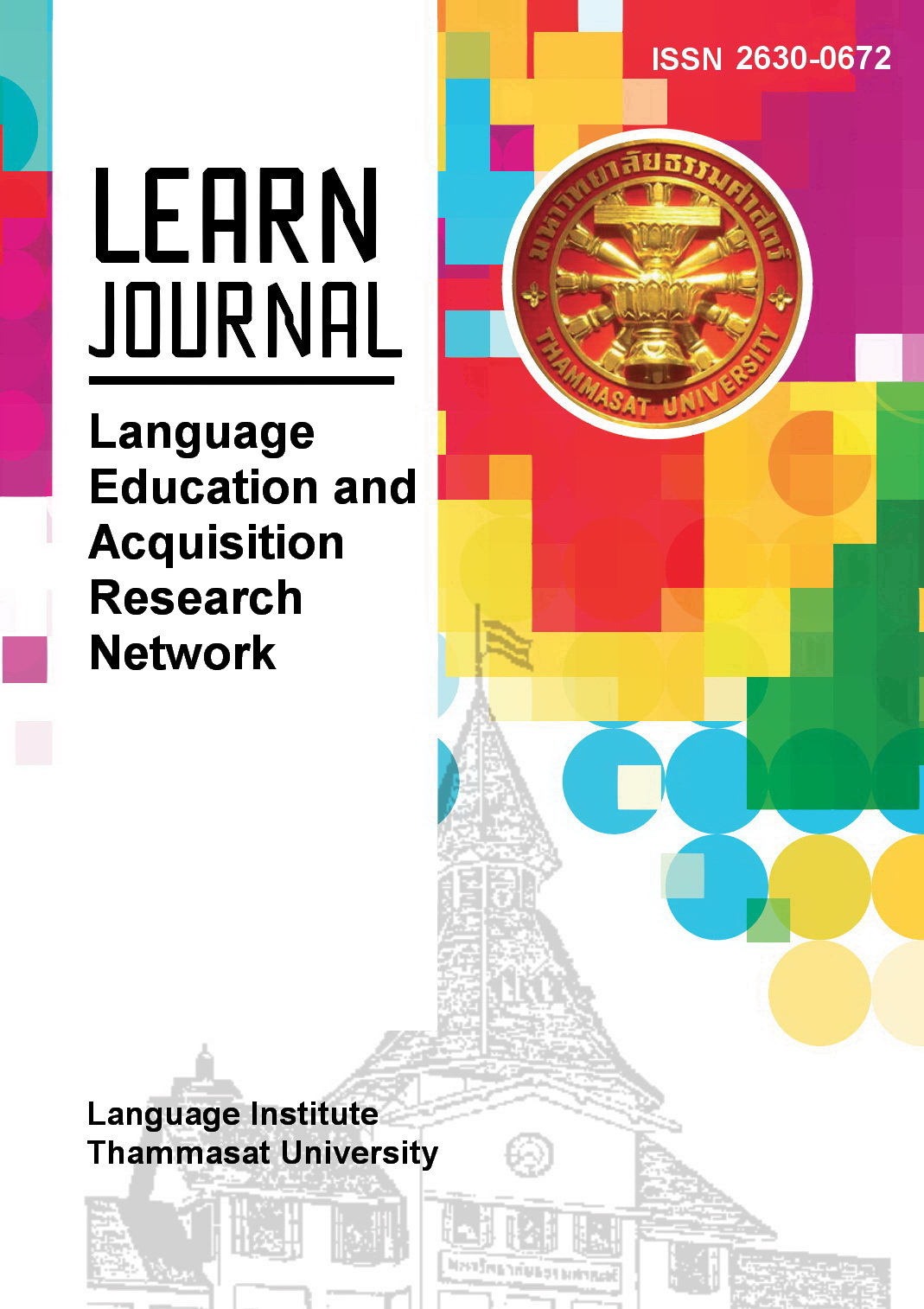Uncovering Fears, Challenges, and Motives of an Adult Learner with Dyslexia through Metaphors
Main Article Content
Abstract
This case study aims to explore English language vocabulary acquisition experiences and conceptualizations of a single adult English language learner with mild dyslexia by drawing on metaphors and semi-structured interviews. In the study, we aimed to view the learner's perception through different lenses to gain deeper insight into her ulterior motives and desire. In the findings, language vocabulary acquisition experiences and conceptualizations attributed to the language were revealed by metaphors. This highlighted the learning barriers which obstructed the learner's foreign language acquisition; her comprehension of the English language and personal motives to overcome the challenges.
Article Details
References
Abadzi, H. (2006). Efficient learning for the poor: Insights from the frontier of cognitive neuroscience. PsycEXTRA Dataset.
https://doi.org/10.1037/e596592012-001
Anthony, S., & Jack, S. (2009). Qualitative case study methodology in nursing research: An integrative review. Journal of Advanced Nursing, 65(6), 1171-1181. https://doi.org/10.1111/j.1365-2648.2009.04998.x
Bacon, A. M., & Bennett, S. (2012). Dyslexia in higher education: The decision to study art. European Journal of Special Needs Education, 28(1), 19-32.
https://doi.org/10.1080/08856257.2012.742748
Berne, J. I., & Blachowicz, C. L. (2008). What reading teachers say about vocabulary instruction: Voices from the classroom. The Reading Teacher, 62(4), 314-323. https://doi.org/10.1598/rt.62.4.4
Cameron, L., & Low, G. (1999). Metaphor. Language Teaching, 32(2), 77-96. https://doi.org/10.1017/s0261444800013781
Coskun, Z. N., & Mitrani, C. (2020). An instructional design for vocabulary acquisition with a hidden disability of dyslexia. Cypriot Journal of Educational Sciences, 15(2), 305 318.
https://doi.org/10.18844/cjes.v15i2.4671
Dinçer, A. (2017). EFL learners' beliefs about speaking English and being a good speaker: A metaphor analysis. Universal Journal of Educational Research, 5(1), 104-112.
https://doi.org/10.13189/ujer.2017.050113
Dyslexia accommodations: How to know what your child needs. (2016, February 12). International Dyslexia Association.
https://dyslexiaida.org/dyslexia
Farjami, H. (2012). EFL learners’ metaphors and images about foreign language learning. Studies in Second Language Learning and Teaching, 2(1), 93. https://doi.org/10.14746/ssllt.2012.2.1.5
Göçen, G., & Özdemirel, A. Y. (2020). Turkish culture in the metaphors and drawings by learners of Turkish as a foreign language. Participatory Educational Research, 7(1), 80-110. https://doi.org/10.17275/per.20.6.7.1
Jin, L., Liang, X., Jiang, C., Zhang, J., Yuan, Y., & Xie, Q. (2014). Studying the motivations of Chinese young EFL learners through metaphor analysis. ELT Journal, 68(3), 286-298.
https://doi.org/10.1093/elt/ccu011
Johnson, K. E., & Stake, R. E. (1996). The art of case study research. The Modern Language Journal, 80(4), 556.
https://doi.org/10.2307/329758
Kormos, J., & Smith, A. M. (2012). Teaching languages to students with specific learning differences. Multilingual Matters
https://doi.org/10.21832/9781847696212
Lakoff, G., & Johnson, M. (1980). Metaphors we live by. University of Chicago Press.
Menghini, D., Finzi, A., Benassi, M., Bolzani, R., Facoetti, A., Giovagnoli, S., Ruffino, M., & Vicari, S. (2010). Different underlying neurocognitive deficits in developmental dyslexia: A comparative study. Neuropsychologia, 48(4), 863-872.
https://doi.org/10.1016/j.neuropsychologia.2009.11.003
Nijakowska, J. (2008). An experiment with direct multisensory instruction
in teaching word reading and spelling to Polish dyslexic learners of English. In Language learners with special needs (pp. 130-157). Multilingual Matters.
Nijakowska, J. (2010). Dyslexia in the foreign language classroom. Multilingual matters. https://doi:10.21832/9781847692818
Nijakowska, J. (2014). Dyslexia in the European EFL teacher training
context. In Essential topics in applied linguistics and multilingualism (pp. 129-154). Springer.
https://doi.org/10.1007/978-3-319-01414-2_8
O'Byrne, C., Jagoe, C., & Lawler, M. (2019). Experiences of dyslexia and the transition to university: A case study of five students at different stages of study. Higher Education Research & Development, 38(5), 1031-1045. https://doi.org/10.1080/07294360.2019.1602595
Peterson, R. L., & Pennington, B. F. (2012). Developmental dyslexia. The Lancet, 379(9830), 1997-2007. https://doi.org/10.1016/s0140-6736(12)60198-6
Crombie, M., & Schneider, E. (2003). Dyslexia and Modern Foreign
Languages: Gaining Success in an Inclusive Context. David Fulton Publishers.
Sicherer, M. (2019). Dyslexia. In College for Students with Learning Disabilities, (pp.17-21) Routledge.
https://doi.org/10.4324/9780429030277-3
Siegel, L. S. (2006). Perspectives on dyslexia. Paediatrics & Child Health, 11(9), 581-587. https://doi.org/10.1093/pch/11.9.581
Simmons, D. C., & Kameenui, E. J. (1990). The effect of task alternatives on vocabulary knowledge: A comparison of students with and without learning disabilities. Journal of Learning Disabilities, 23(5), 291-297. https://doi.org/10.1177/002221949002300508
Simon, C. S. (2000). Dyslexia and learning a foreign language: A personal experience. Annals of Dyslexia, 50(1), 155-187.
https://doi.org/10.1007/s11881-000-0021-7
Sparks, R. L., Patton, J., Ganschow, L., Humbach, N., & Javorsky, J. (2006). Native language predictors of foreign language proficiency and foreign language aptitude. Annals of Dyslexia, 56(1), 129-160. https://doi:10.1007/s11881-006-0006-2
Şenaydın, F., & Dikilitaş, K. (2019). Exploring child bilingual identity in Turkish context: A single case study. International Journal of Bilingual Education and Bilingualism, 1-17.
https://doi.org/10.1080/13670050.2019.1639130
Stampoltzis, A., & Polychronopoulou, S. (2009). Greek university students with dyslexia: An interview study. European Journal of Special Needs Education, 24(3), 307-321.
https://doi.org/10.1080/08856250903020195
Swarbrick, J., & Marshall, A. (2004). The everything parent's guide to children with dyslexia: All you need to ensure your child's success. Simon & Schuster.
Tanner, K. (2009). Adult dyslexia and the ‘conundrum of failure’.
Disability & Society, 24(6), 785-797. https://doi.org/10.1080/09687590903160274
Worthy, J., DeJulio, S., Svrcek, N., Villarreal, D. A., Derbyshire, C., LeeKeenan, K., Wiebe, M. T., Lammert, C., Rubin, J. C., & Salmerón, C. (2016). Teachers’ understandings, perspectives, and experiences of dyslexia. Literacy Research: Theory, Method, and Practice, 65(1), 436-453.


